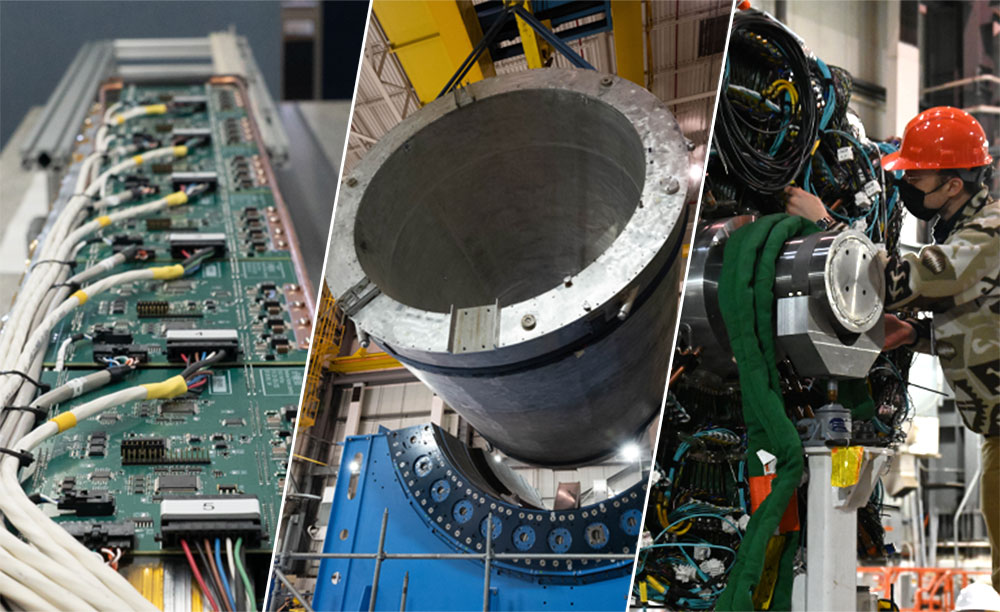Like a massive, 3D digital camera, sPHENIX will capture snapshots of 15,000 particle collisions per second to provide scientists with data to better understand the properties of quark-gluon plasma (QGP)—an ultra-hot and ultra-dense soup of subatomic particles that are the building blocks of nearly all visible matter. RHIC collisions briefly recreate the conditions of the universe a fraction of a second after the Big Bang, some 14 billion years ago. Studying QGP can help physicists learn about the origins of matter as we know it and how nature’s strongest force binds quarks and gluons into protons and neutrons, the particles that make up ordinary atomic nuclei.
“Brookhaven National Laboratory continues to be a central hub of nuclear physics expertise, making it the world’s premier facility for studying the quark gluon plasma,” said Asmeret Asefaw Berhe, DOE’s Director of the Office of Science. “The sPHENIX detector, and the talented collaboration that will operate it, will strive to give us that answer and the final piece of the quark-gluon puzzle.”
Brookhaven Lab Director Doon Gibbs said, “sPHENIX marks a key milestone in the RHIC science program. It will allow us to explore many questions raised by incredible discoveries already made at RHIC, especially the surprising liquid nature of the quark-gluon plasma, and lay the foundation for future discoveries at the Electron-Ion Collider. I congratulate and thank all the scientists, engineers, technicians, and support staff at Brookhaven—and sPHENIX collaborators around the world—who have worked together to make this detector possible.”
At the core of sPHENIX is a 20-ton cylindrical superconducting magnet that will bend the trajectories of charged particles produced in RHIC collisions. The magnet is surrounded and filled with subsystems that include complex silicon detectors, a Time Projection Chamber, and calorimeters that will capture details of particle jets, heavy quarks, and rare, high-momentum particles fast and accurately. These advanced particle tracking systems will allow nuclear physicists to probe properties of the quark-gluon plasma with higher precision than ever before to understand how the interactions between quarks and gluons give rise to the unique, liquid-like behavior of QGP.
“Our detector employs 100,000 silicon photomultipliers, calorimeter elements built using 3-D printing techniques and a 300 million channel radiation-hard silicon detector that has its sensor and electronics integrated into a monolithic device,” said sPHENIX project director Ed O’Brien.
Many sPHENIX detector components build on experience gained throughout RHIC operations and draw on expertise throughout the nuclear and particle physics communities, including running experiments at Europe’s Large Hadron Collider.
“These technologies were barely on the drawing board when RHIC began operations over 20 years ago,” O’Brien said. “Now they are a reality in sPHENIX.”
“We’ve pulled together the field’s most sophisticated technologies and pushed them to new limits to design a detector unlike any that have come before,” said Brookhaven Lab physicist and sPHENIX co-spokesperson David Morrison. “It’s really a technological marvel.”
sPHENIX will generate an enormous amount of data to realize its science goals. Developing the capabilities to collect, store, share, and analyze that data will help push the limits of data handling in ways that could benefit other fields including climate modeling, public health, and any fields that require the analysis of huge datasets.
Learn more about sPHENIX and watch as some of its components came together.
sPHENIX was built by an international collaboration of physicists, engineers, and technicians from 80 universities and labs from 14 countries—close to 400 collaborators overall, including students. Students, for example, joined efforts to assemble and test complex detector subsystems, studied cost-effective materials for high-speed electronics, and contributed to accelerator improvements that will increase collision rates at RHIC.
“These hands-on educational experiences are providing valuable training for our nation’s future scientists, technicians, and engineers,” said sPHENIX co-spokesperson Gunther Roland, a physicist at the Massachusetts Institute of Technology. “Their expertise and future work may impact fields well beyond fundamental physics that rely on similar sophisticated electronics and cutting-edge technologies—including medical imaging and national security.”
sPHENIX and operations at RHIC are funded by the DOE Office of Science (NP).
Brookhaven National Laboratory is supported by the Office of Science of the U.S. Department of Energy. The Office of Science is the single largest supporter of basic research in the physical sciences in the United States and is working to address some of the most pressing challenges of our time. For more information, visit science.energy.gov.
Follow @BrookhavenLab on Twitter or find us on Facebook.


